In 1914, Charles Chaplin signed on at the Essanay Film Manufacturing Company, where he made 15 films. Jeffrey Vance in his book 'Chaplin: Genius of the Cinema': "If the early slapstick of the Keystone comedies represents Chaplin’s cinematic infancy, the films he made for the Essanay Film Manufacturing Company are his adolescence. The Essanays find Chaplin in transition, taking greater time and care with each film, experimenting with new ideas, and adding flesh to the Tramp character that would become his legacy. Chaplin’s Essanay comedies reveal an artist experimenting with his palette and finding his craft." In Great Britain, a series of Red Letter photo cards was published with pictures of Chaplin's Essanay films. The titles on the cards are the British film titles.

British postcard by Red Letter. Photo: Essanay. Charlie Chaplin and Spike the Bulldog in The Champion/Champion Charlie (Charles Chaplin, 1915). Caption: Charlie and the Bulldog.
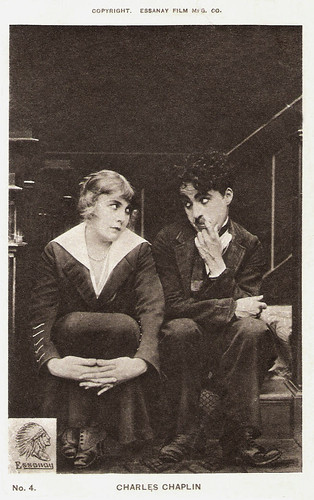
British postcard by Red Letter, no. 4. Photo: Essanay. Charlie Chaplin and Edna Purviance. A major asset of the Essanay films was the addition of Edna Purviance to Chaplin's roster of supporting players. Her natural beauty and poise let a romantic ambiance to the proceedings that allowed Chaplin's character to exhibit hitherto unseen traces of warmth and humanity.
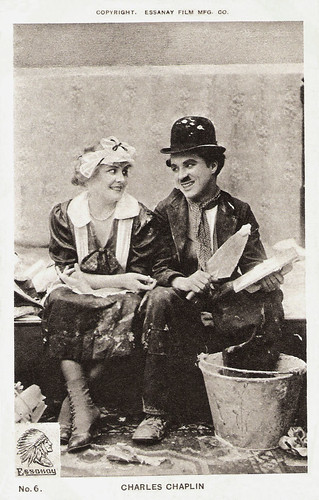
British postcard by Red Letter, no. 6. Photo: Essanay. Charlie Chaplin and Edna Purviance in Work (Charles Chaplin, 1915).

British postcard by Red Letter Photocard. Caption: Charlie in Private Life.
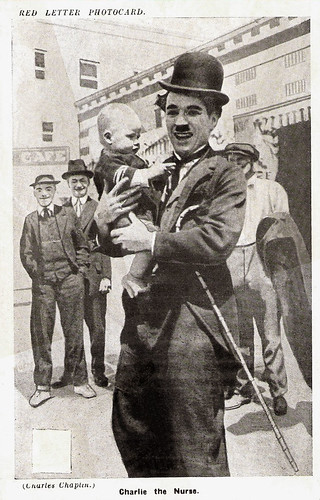
British Postcard by Red Letter. Photo: Keystone. Charlie Chaplin in His Trysting Place (Charles Chaplin, 1914). Caption: Charlie the Nurse. One of Chaplin's last Keystone productions. Note that the Essanay logo of the Indian is left out.
The company was founded in 1907 as the Peerless Film Manufacturing Company. Its two founders were George K. Spoor, who provided the financing and managed the company, and G.M. Anderson, better known as 'Broncho Billy' Anderson, cinema’s first cowboy star. The name Essanay was formed from their surname initials, S and A in August 1907.
Essanay’s headquarters were in Chicago, Illinois, and the company had a second studio in Niles, a suburb of San Francisco. Essanay's first film was An Awful Skate, or The Hobo on Rollers (1907), starring Ben Turpin, who then worked as the studio janitor. The film was produced for only a couple hundred dollars and grossed several thousand dollars in release.
The studio prospered and a year later Essanay became a member of the powerful Motion Picture Patents Company. Essanay produced silent films with such stars as George Periolat, Ben Turpin, Wallace Beery, Thomas Meighan, Colleen Moore, and Francis X. Bushman. The mainstay of the organisation, however, was studio co-owner, Anderson, starring in the very popular 'Broncho Billy' Westerns
In November 1914, Essanay lured Charlie Chaplin from Mack Sennett's Keystone Studios. He was paid an unprecedented salary of $1,250 per week, with a bonus of $10,000 for merely signing with the company. Chaplin made 14 short comedies for Essanay in 1915, at both the Chicago and Niles studios, plus a cameo appearance in one of the Broncho Billy Westerns.
The landmark film of the Chaplin series is The Tramp (Charles Chaplin, 1915), in which Chaplin's vagabond character finds work on a farm and is smitten with the farmer's daughter (Edna Purviance). Chaplin injected moments of drama and pathos unheard of in slapstick comedies (the tramp is felled by a gunshot wound, and then disappointed in romance). The film ends with the famous shot of the lonely tramp with his back to the camera, walking down the road dejectedly, and then squaring his shoulders optimistically and heading for his next adventure.
Chaplin's stock company at Essanay included Ben Turpin, who disliked working with the meticulous Chaplin and appeared with him in only a couple of films; ingenue Edna Purviance, who became his off-screen sweetheart as well; Leo White, almost always playing a fussy continental villain; and all-purpose authority figures Bud Jamison and John Rand.
Chaplin disliked the unpredictable weather of Chicago and left after only one year for more money and more creative control elsewhere. His departure caused a rift between founders Spoor and Anderson. Chaplin was the studio's biggest moneymaker, and Essanay resorted to creating 'new' Chaplin comedies from file footage and out-takes. Finally, with Chaplin off the Essanay scene for good, Essanay signed French comedian Max Linder, whose clever pantomime, often compared to Chaplin's, failed to match Chaplin's popularity in America.
Charlie Chaplin’s one year with the company was its zenith. Essanay foundered after Chaplin left to join the Mutual Film Corporation and finally ceased operations in 1918. Years later, both George K. Spoor (in 1948) and Gilbert M. 'Broncho Billy' Anderson (in 1958) received Oscars, specifically Academy Honorary Awards, for their pioneering efforts with Essanay.

British postcard by Red Letter. Photo: Essanay. Charlie Chaplin and Charlotte Mineau in His New Job/Charlie's New Job (Charles Chaplin, 1915). Caption: Making Love to the Queen. His New Job was Chaplin's first film for Essanay, filmed in their studio in Chicago. All his later films were made in Niles, California.

British postcard by Red Letter Photocard. Photo: Essanay. Charlie Chaplin as a would-be pugilist, and Leo White as a crooked gambler in The Champion/Champion Charlie (Charles Chaplin, 1915). Caption: Charlie up against it.

British postcard by Red Letter. Photo: Essanay. Charlie Chaplin in A Jitney Elopement/Charlie's Elopement (Charles Chaplin 1915). Right of him Edna Purviance as Edna and Ernest Van Pelt as Edna's father. The other two men are the Old and The Young Butler, played by Paddy McGuire and Lloyd Bacon. Caption: The Bogus Count.

British postcard by Red Letter. Photo: Essanay. Charlie Chaplin in A Jitney Elopement/Charlie's Elopement (Charles Chaplin, 1915). Caption: Charlie Threatens Count.
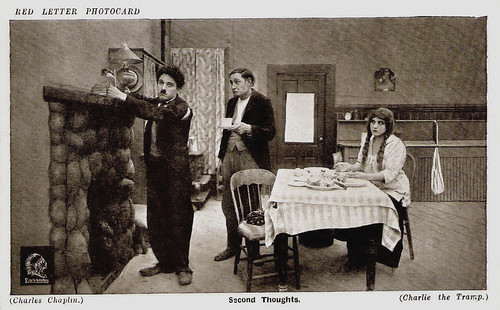
British postcard by Red Letter. Photo: Essanay. Charlie Chaplin as The Tramp, Ernest Van Pelt as The Farmer, and Edna Purviance as The Farmer's Daughter in The Tramp/Charlie the Tramp (Charles Chaplin, 1915). Caption: Second Thoughts.

British postcard by Red Letter. Photo: Essanay. Charlie Chaplin as the Tramp, Ernest Van Pelt as the Farmer, and Paddy McGuire as the Farmhand in The Tramp/Charlie the Tramp (Charles Chaplin, 1915). Caption: Charlie Yawns.

British postcard by Red Letter. Photo: Essanay. Charlie Chaplin and Margie Reiger flirt in By the Sea/Charlie by the Sea (Charles Chaplin, 1915), while Bud Jamison and Billy Armstrong are not too happy about this, and Edna Purviance fears trouble is coming up. The film was shot at Crystal Pear in Los Angeles. Caption: Charlie's Flirtation.
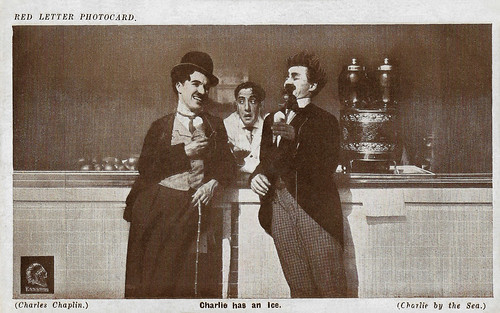
British postcard by Red Letter. Photo: Essanay. Charlie Chaplin and Billy Armstrong enjoy an ice cream after their fight in By the Sea/Charlie by the Sea (Charles Chaplin, 1915). The ice cream clerk is 'Snub' Pollard. Caption: Charlie has an Ice.

British postcard by Red Letter. Photo: Essanay. Charlie Chaplin and Edna Purviance in A Woman/Charlie the Perfect Lady (Charles Chaplin, 1915). Caption: Impressive Charlie.
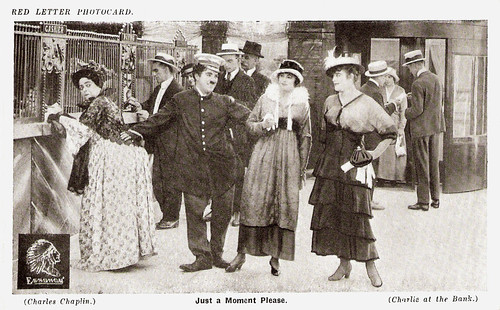
British postcard by Red Letter. Photo: Essanay. Charlie Chaplin in The Bank/Charlie at the Bank (Charles Chaplin, 1915). Caption: Just a Moment Please.

British postcard by Red Letter. Photo: Essanay. Charlie Chaplin as a janitor in The Bank/Charlie at the Bank (Charles Chaplin, 1915). Left Edna Purviance as Edna, the secretary. The other man is probably Billy Armstrong, who plays another janitor. Caption: Love is Blind.
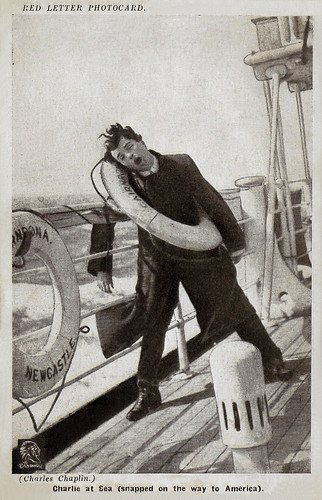
British postcard by Red Letter. Photo: Essanay. Charlie Chaplin in Shanghaied (Charles Chaplin, 1915). Caption: Charlie at Sea (snapped on the way to America).

British postcard by Red Letter. Photo: Essanay. Charlie Chaplin in his film A Night in the Show/Charlie at the Show (Charles Chaplin, 1915), in which he played a double role. Right of him Edna Purviance, the man may be George Cleethorpe. Caption: Unrequited Love.

British postcard by Red Letter. Photo: Essanay. Charlie Chaplin in A Night in the Show/Charlie at the Show (Charles Chaplin, 1915), in which he played a double role. The woman with the feathers was played by Carrie Clark Ward. Caption: A Ticklish Job.
Sources: Ted Okuda and David Maska (Charlie Chaplin at Keystone and Essanay: Dawn of the Tramp), Jeffrey Vance (Chaplin: Genius of the Cinema), Wikipedia, and IMDb.

British postcard by Red Letter. Photo: Essanay. Charlie Chaplin and Spike the Bulldog in The Champion/Champion Charlie (Charles Chaplin, 1915). Caption: Charlie and the Bulldog.

British postcard by Red Letter, no. 4. Photo: Essanay. Charlie Chaplin and Edna Purviance. A major asset of the Essanay films was the addition of Edna Purviance to Chaplin's roster of supporting players. Her natural beauty and poise let a romantic ambiance to the proceedings that allowed Chaplin's character to exhibit hitherto unseen traces of warmth and humanity.

British postcard by Red Letter, no. 6. Photo: Essanay. Charlie Chaplin and Edna Purviance in Work (Charles Chaplin, 1915).

British postcard by Red Letter Photocard. Caption: Charlie in Private Life.

British Postcard by Red Letter. Photo: Keystone. Charlie Chaplin in His Trysting Place (Charles Chaplin, 1914). Caption: Charlie the Nurse. One of Chaplin's last Keystone productions. Note that the Essanay logo of the Indian is left out.
The Essanay Film Manufacturing Company
The company was founded in 1907 as the Peerless Film Manufacturing Company. Its two founders were George K. Spoor, who provided the financing and managed the company, and G.M. Anderson, better known as 'Broncho Billy' Anderson, cinema’s first cowboy star. The name Essanay was formed from their surname initials, S and A in August 1907.
Essanay’s headquarters were in Chicago, Illinois, and the company had a second studio in Niles, a suburb of San Francisco. Essanay's first film was An Awful Skate, or The Hobo on Rollers (1907), starring Ben Turpin, who then worked as the studio janitor. The film was produced for only a couple hundred dollars and grossed several thousand dollars in release.
The studio prospered and a year later Essanay became a member of the powerful Motion Picture Patents Company. Essanay produced silent films with such stars as George Periolat, Ben Turpin, Wallace Beery, Thomas Meighan, Colleen Moore, and Francis X. Bushman. The mainstay of the organisation, however, was studio co-owner, Anderson, starring in the very popular 'Broncho Billy' Westerns
In November 1914, Essanay lured Charlie Chaplin from Mack Sennett's Keystone Studios. He was paid an unprecedented salary of $1,250 per week, with a bonus of $10,000 for merely signing with the company. Chaplin made 14 short comedies for Essanay in 1915, at both the Chicago and Niles studios, plus a cameo appearance in one of the Broncho Billy Westerns.
The landmark film of the Chaplin series is The Tramp (Charles Chaplin, 1915), in which Chaplin's vagabond character finds work on a farm and is smitten with the farmer's daughter (Edna Purviance). Chaplin injected moments of drama and pathos unheard of in slapstick comedies (the tramp is felled by a gunshot wound, and then disappointed in romance). The film ends with the famous shot of the lonely tramp with his back to the camera, walking down the road dejectedly, and then squaring his shoulders optimistically and heading for his next adventure.
Chaplin's stock company at Essanay included Ben Turpin, who disliked working with the meticulous Chaplin and appeared with him in only a couple of films; ingenue Edna Purviance, who became his off-screen sweetheart as well; Leo White, almost always playing a fussy continental villain; and all-purpose authority figures Bud Jamison and John Rand.
Chaplin disliked the unpredictable weather of Chicago and left after only one year for more money and more creative control elsewhere. His departure caused a rift between founders Spoor and Anderson. Chaplin was the studio's biggest moneymaker, and Essanay resorted to creating 'new' Chaplin comedies from file footage and out-takes. Finally, with Chaplin off the Essanay scene for good, Essanay signed French comedian Max Linder, whose clever pantomime, often compared to Chaplin's, failed to match Chaplin's popularity in America.
Charlie Chaplin’s one year with the company was its zenith. Essanay foundered after Chaplin left to join the Mutual Film Corporation and finally ceased operations in 1918. Years later, both George K. Spoor (in 1948) and Gilbert M. 'Broncho Billy' Anderson (in 1958) received Oscars, specifically Academy Honorary Awards, for their pioneering efforts with Essanay.

British postcard by Red Letter. Photo: Essanay. Charlie Chaplin and Charlotte Mineau in His New Job/Charlie's New Job (Charles Chaplin, 1915). Caption: Making Love to the Queen. His New Job was Chaplin's first film for Essanay, filmed in their studio in Chicago. All his later films were made in Niles, California.

British postcard by Red Letter Photocard. Photo: Essanay. Charlie Chaplin as a would-be pugilist, and Leo White as a crooked gambler in The Champion/Champion Charlie (Charles Chaplin, 1915). Caption: Charlie up against it.

British postcard by Red Letter. Photo: Essanay. Charlie Chaplin in A Jitney Elopement/Charlie's Elopement (Charles Chaplin 1915). Right of him Edna Purviance as Edna and Ernest Van Pelt as Edna's father. The other two men are the Old and The Young Butler, played by Paddy McGuire and Lloyd Bacon. Caption: The Bogus Count.

British postcard by Red Letter. Photo: Essanay. Charlie Chaplin in A Jitney Elopement/Charlie's Elopement (Charles Chaplin, 1915). Caption: Charlie Threatens Count.

British postcard by Red Letter. Photo: Essanay. Charlie Chaplin as The Tramp, Ernest Van Pelt as The Farmer, and Edna Purviance as The Farmer's Daughter in The Tramp/Charlie the Tramp (Charles Chaplin, 1915). Caption: Second Thoughts.

British postcard by Red Letter. Photo: Essanay. Charlie Chaplin as the Tramp, Ernest Van Pelt as the Farmer, and Paddy McGuire as the Farmhand in The Tramp/Charlie the Tramp (Charles Chaplin, 1915). Caption: Charlie Yawns.

British postcard by Red Letter. Photo: Essanay. Charlie Chaplin and Margie Reiger flirt in By the Sea/Charlie by the Sea (Charles Chaplin, 1915), while Bud Jamison and Billy Armstrong are not too happy about this, and Edna Purviance fears trouble is coming up. The film was shot at Crystal Pear in Los Angeles. Caption: Charlie's Flirtation.

British postcard by Red Letter. Photo: Essanay. Charlie Chaplin and Billy Armstrong enjoy an ice cream after their fight in By the Sea/Charlie by the Sea (Charles Chaplin, 1915). The ice cream clerk is 'Snub' Pollard. Caption: Charlie has an Ice.

British postcard by Red Letter. Photo: Essanay. Charlie Chaplin and Edna Purviance in A Woman/Charlie the Perfect Lady (Charles Chaplin, 1915). Caption: Impressive Charlie.

British postcard by Red Letter. Photo: Essanay. Charlie Chaplin in The Bank/Charlie at the Bank (Charles Chaplin, 1915). Caption: Just a Moment Please.

British postcard by Red Letter. Photo: Essanay. Charlie Chaplin as a janitor in The Bank/Charlie at the Bank (Charles Chaplin, 1915). Left Edna Purviance as Edna, the secretary. The other man is probably Billy Armstrong, who plays another janitor. Caption: Love is Blind.

British postcard by Red Letter. Photo: Essanay. Charlie Chaplin in Shanghaied (Charles Chaplin, 1915). Caption: Charlie at Sea (snapped on the way to America).

British postcard by Red Letter. Photo: Essanay. Charlie Chaplin in his film A Night in the Show/Charlie at the Show (Charles Chaplin, 1915), in which he played a double role. Right of him Edna Purviance, the man may be George Cleethorpe. Caption: Unrequited Love.

British postcard by Red Letter. Photo: Essanay. Charlie Chaplin in A Night in the Show/Charlie at the Show (Charles Chaplin, 1915), in which he played a double role. The woman with the feathers was played by Carrie Clark Ward. Caption: A Ticklish Job.
Sources: Ted Okuda and David Maska (Charlie Chaplin at Keystone and Essanay: Dawn of the Tramp), Jeffrey Vance (Chaplin: Genius of the Cinema), Wikipedia, and IMDb.
2 comments:
Charlie Chaplin was an amazing man. This post is special--I enjoyed every single thing about it, Paul. Thank you so much for all your research into these people's lives. I think many would be forgotten if not for you.
Thank you, Beth!
Post a Comment